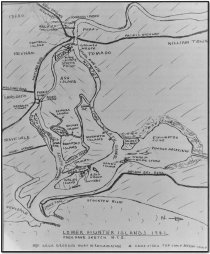
ASH ISLAND – MOSCHETO ISLAND
Article from The Richmond River Herald and Northern Districts Advertiser (NSW : 1886 – 1942), Friday 2 August 1918, page 7
by Cherylanne Bailey
IN EARLY HISTORY
Moscheto Island is one of the landmarks of the Hunter River. It has been that for a hundred years, and for more than half that period Newcastle drew from it much of the fruit, vegetables, and dairy products that were required for its daily needs. In the early stages of the island’s history, its activities were three in number, being confined to vegetable and fruit culture and fishing. The first locally-grown fruit was marketed from there. In order to encourage settlement, grants were made to those who desired to follow a career on the land. The soil and temperate climate were ideal for fruit culture, and peaches were grown with much success. The fruit was not, as is done now, put up in cases. It was ‘shipped’ across to Newcastle in open boats, which were drawn up near the bank of the river, and the fruit loaded into them in bulk. The death-knell of this industry was sound when a smelting works was established on the site now occupied by the steel works. The trees, which afforded a natural wind screen for the orchard, were destroyed by the sulphus fumes, just as have the trees and vegetation surrounding the ore-treating works at Cockle Creek.
Oystering and fishering were then taken up by the settlers, who made good wages. Anything from £1 to 40s a day was common. A succession of floods destroyed the oyster beds for a time, and the younger men who were following that occupation packed up and went north. On the wealthy northern rivers they did well. The pioneers of the Clarence, Bellinger, Richmond, and Macleay Rivers were early in their careers associated with the Hunter. Those who remained behind turned their attention to dairying, and for a great many years this was the only industry pursued on Moscheto Island. In 1914 the Government determined to resume the area. Although this comprises about 1500 acres, only about one-third of the land is suitable for the purpose to which it has been put. The remainder is subject to the tidal waters, and is at intervals submerged. With the commencement of resumption dairying practically ended. Industries were established only to be overtaken by fate of one kind or another
The island had its progress association, inevitably. The settlers for years had no means, other than the small rowing boats, of communication with the mainland. When Mr Ninian Melville, MP, was urged to assist in securing justice to Moscheto island, “Where,’” he asked, “is Moscheto Island?” Mr WL Kidd, the Postmaster-General of a bygone period, was the first Minister of the Crown to pay a visit to the island— not now a well cared-for corner of the great Hunter district, but rather a portion of ‘no-man’s land.’ Its waving fields of green are there no longer. Of the rivalry that once existed between the old stock , owners and crop-raisers, one now sees nothing. Its fences, sheds, and buildings are in general disrepair. There are still a few dairy farmers in occupation of leaseholds, which are granted only on a quarterly tenancy. There is nothing to encourage men to put effort into their enterprise, as was the case in the days of the Turners, Dempseys, Jordans, Bedfords, Croeses, Tongues, Newtons, Forsters, Morrises, Pilleys- names that are still familiar with Moscheto Island’s story. One of its first settlers was the late Captain Tonkins RN, who was interred on his own farm in the grave that he had himself carefully prepared. His remains, together with those of his wife, were early this year taken up and removed to the Sandgate cemetery. He was 91 years of age at the time of his death. His wife was some years younger.
The little chapel on the only notable hill on the island still stands, although lacking the care that its trusty worshippers accorded it in that far-back time. It was consecrated more than half a century ago by Mr JD Langley, who was the manager of the Bank of Australasia. He was afterwards Bishop Langley, and had charge of a diocese in Victoria. There is, too, the little school, whose first principal was M. Robinson. He was followed by M. Phillips. The island had also its post and telegraph office. For thirty years Mr JT Turner, now of Tighe’s Hill, was the post-master, and held the mail contract between the island and Newcastle.
There is still a good deal of uncertainty as to how Moscheto Island got the name it bears. To most of the inhabitants of the district it is ‘Mosquito Island,’ and it is ‘Mosquito Island’ because of the special size, shape and characteristics of the mosquitoes originally found there. That, at all events, is the average explanation. Then there is the account that the island was called after a young lieutenant who accompanied Commander Hunter to the colony, when Hunter’s River was a very little known quantity. An other version is that ‘Moscheto’ and ‘Mosquito’ are interchangeable, the former being a Spanish corruption of the name. Whether that is so or not, it has always been Moscheto in all Government departments, old and new plans bearing that name, and on none of the plans is there any trace of the name “Mosquito” Island.
